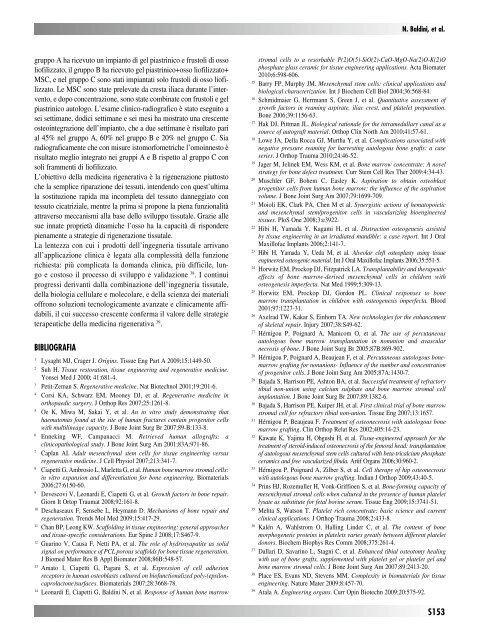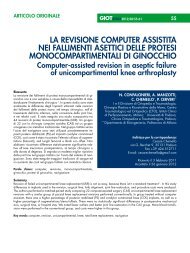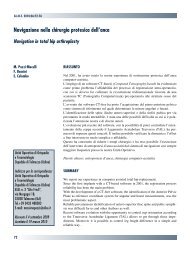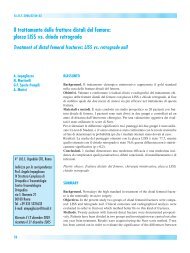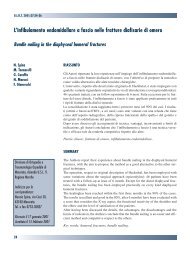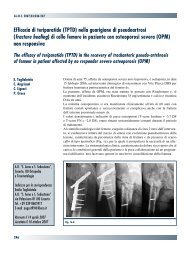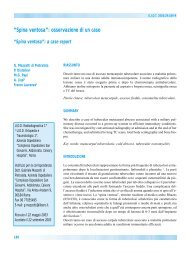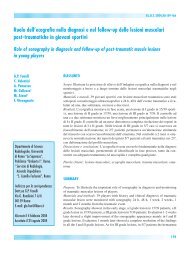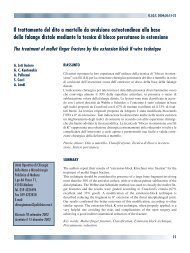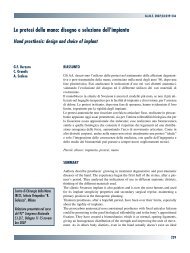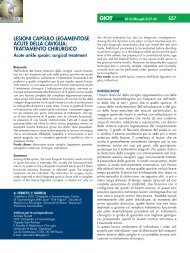30845 Suppl Giot.pdf - Giornale Italiano di Ortopedia e Traumatologia
30845 Suppl Giot.pdf - Giornale Italiano di Ortopedia e Traumatologia
30845 Suppl Giot.pdf - Giornale Italiano di Ortopedia e Traumatologia
Create successful ePaper yourself
Turn your PDF publications into a flip-book with our unique Google optimized e-Paper software.
gruppo A ha ricevuto un impianto <strong>di</strong> gel piastrinico e frustoli <strong>di</strong> osso<br />
liofilizzato, il gruppo B ha ricevuto gel piastrinico+osso liofilizzato+<br />
MSC, e nel gruppo C sono stati impiantati solo frustoli <strong>di</strong> osso liofilizzato.<br />
Le MSC sono state prelevate da cresta iliaca durante l’intervento,<br />
e dopo concentrazione, sono state combinate con frustoli e gel<br />
piastrinico autologo. L’esame clinico-ra<strong>di</strong>ografico è stato eseguito a<br />
sei settimane, do<strong>di</strong>ci settimane e sei mesi ha mostrato una crescente<br />
osteointegrazione dell’impianto, che a due settimane è risultato pari<br />
al 45% nel gruppo A, 60% nel gruppo B e 20% nel gruppo C. Sia<br />
ra<strong>di</strong>ograficamente che con misure istomorfometriche l’omoinnesto è<br />
risultato meglio integrato nei gruppi A e B rispetto al gruppo C con<br />
soli frammenti <strong>di</strong> liofilizzato.<br />
L’obiettivo della me<strong>di</strong>cina rigenerativa è la rigenerazione piuttosto<br />
che la semplice riparazione dei tessuti, intendendo con quest’ultima<br />
la sostituzione rapida ma incompleta del tessuto danneggiato con<br />
tessuto cicatriziale, mentre la prima si propone la piena funzionalità<br />
attraverso meccanismi alla base dello sviluppo tissutale. Grazie alle<br />
sue innate proprietà <strong>di</strong>namiche l’osso ha la capacità <strong>di</strong> rispondere<br />
pienamente a strategie <strong>di</strong> rigenerazione tissutale.<br />
La lentezza con cui i prodotti dell’ingegneria tissutale arrivano<br />
all’applicazione clinica è legata alla complessità della funzione<br />
richiesta: più complicata la domanda clinica, più <strong>di</strong>fficile, lungo<br />
e costoso il processo <strong>di</strong> sviluppo e validazione 38 . I continui<br />
progressi derivanti dalla combinazione dell’ingegneria tissutale,<br />
della biologia cellulare e molecolare, e della scienza dei materiali<br />
offrono soluzioni tecnologicamente avanzate e clinicamente affidabili,<br />
il cui successo crescente conferma il valore delle strategie<br />
terapeutiche della me<strong>di</strong>cina rigenerativa 39 .<br />
BIBLIOGraFIa<br />
1 Lysaght MJ, Crager J. Origins. Tissue Eng Part A 2009;15:1449-50.<br />
2 Suh H. Tissue restoration, tissue engineering and regenerative me<strong>di</strong>cine.<br />
Yonsei Med J 2000; 41:681-4.<br />
3 Petit-Zeman S. Regenerative me<strong>di</strong>cine. Nat Biotechnol 2001;19:201-6.<br />
4 Corsi KA, Schwarz EM, Mooney DJ, et al. Regenerative me<strong>di</strong>cine in<br />
orthopae<strong>di</strong>c surgery. J Orthop Res 2007;25:1261-8.<br />
5 Oe K, Miwa M, Sakai Y, et al. An in vitro study demonstrating that<br />
haematomas found at the site of human fractures contain progenitor cells<br />
with multilineage capacity. J Bone Joint Surg Br 2007;89-B:133-8.<br />
6 Enneking WF, Campanacci M. Retrieved human allografts: a<br />
clinicopathological study. J Bone Joint Surg Am 2001;83A:971-86.<br />
7 Caplan AI. Adult mesenchymal stem cells for tissue engineering versus<br />
regenerative me<strong>di</strong>cine. J Cell Physiol 2007;213:341-7.<br />
8 Ciapetti G, Ambrosio L, Marletta G, et al. Human bone marrow stromal cells:<br />
in vitro expansion and <strong>di</strong>fferentiation for bone engineering. Biomaterials<br />
2006;27:6150-60.<br />
9 Devescovi V, Leonar<strong>di</strong> E, Ciapetti G, et al. Growth factors in bone repair.<br />
Giorn It Ortop Traumat 2008;92:161-8.<br />
10 Deschaseaux F, Sensebe L, Heymann D. Mechanisms of bone repair and<br />
regeneration. Trends Mol Med 2009;15:417-29.<br />
11 Chan BP, Leong KW. Scaffol<strong>di</strong>ng in tissue engineering: general approaches<br />
and tissue-specific considerations. Eur Spine J 2008;17:S467-9.<br />
12 Guarino V, Causa F, Netti PA, et al. The role of hydroxyapatite as solid<br />
signal on performance of PCL porous scaffolds for bone tissue regeneration.<br />
J Biomed Mater Res B Appl Biomater 2008;86B:548-57.<br />
13 Amato I, Ciapetti G, Pagani S, et al. Expression of cell adhesion<br />
receptors in human osteoblasts cultured on biofunctionalized poly-(epsiloncaprolactone)surfaces.<br />
Biomaterials 2007;28:3668-78.<br />
14 Leonar<strong>di</strong> E, Ciapetti G, Bal<strong>di</strong>ni N, et al. Response of human bone marrow<br />
N. Bal<strong>di</strong>ni, et al.<br />
stromal cells to a resorbable P(2)O(5)-SiO(2)-CaO-MgO-Na(2)O-K(2)O<br />
phosphate glass ceramic for tissue engineering applications. Acta Biomater<br />
2010;6:598-606.<br />
15 Barry FP, Murphy JM. Mesenchymal stem cells: clinical applications and<br />
biological characterization. Int J Biochem Cell Biol 2004;36:568-84.<br />
16 Schmidmaier G, Herrmann S, Green J, et al. Quantitative assessment of<br />
growth factors in reaming aspirate, iliac crest, and platelet preparation.<br />
Bone 2006;39:1156-63.<br />
17 Hak DJ, Pittman JL. Biological rationale for the intramedullary canal as a<br />
source of autograft material. Orthop Clin North Am 2010;41:57-61.<br />
18 Lowe JA, Della Rocca GJ, Murtha Y, et al. Complications associated with<br />
negative pressure reaming for harvesting autologous bone grafts: a case<br />
series. J Orthop Trauma 2010;24:46-52.<br />
19 Jager M, Jelinek EM, Wess KM, et al. Bone marrow concentrate: A novel<br />
strategy for bone defect treatment. Curr Stem Cell Res Ther 2009:4:34-43.<br />
20 Muschler GF, Bohem C, Easley K. Aspiration to obtain osteoblast<br />
progenitor cells from human bone marrow: the influence of the aspiration<br />
volume. J Bone Joint Surg Am 2007;79:1699-709.<br />
21 Moioli EK, Clark PA, Chen M et al. Synergistic actions of hematopoietic<br />
and mesenchymal stem/progenitor cells in vascularizing bioengineered<br />
tissues. PloS One 2008;3:e3922.<br />
22 Hibi H, Yamada Y, Kagami H, et al. Distraction osteogenesis assisted<br />
by tissue engineering in an irra<strong>di</strong>ated man<strong>di</strong>ble: a case report. Int J Oral<br />
Maxillofac Implants 2006;2:141-7.<br />
23 Hibi H, Yamada Y, Ueda M, et al. Alveolar cleft osteoplasty using tissue<br />
engineered osteogenic material. Int J Oral Maxillofac Implants 2006;35:551-5.<br />
24 Horwitz EM, Prockop DJ, Fitzpatrick LA. Transplantability and therapeutic<br />
effects of bone marrow-derived mesenchymal cells in children with<br />
osteogenesis imperfecta. Nat Med 1999;5:309-13.<br />
25 Horwitz EM, Prockop DJ, Gordon PL. Clinical responses to bone<br />
marrow transplantation in children with osteogenesis imperfecta. Blood<br />
2001;97:1227-31.<br />
26 Axelrad TW, Kakar S, Einhorn TA. New technologies for the enhancement<br />
of skeletal repair. Injury 2007;38:S49-62.<br />
27 Hérnigou P, Poignard A, Manicom O, et al. The use of percutaneous<br />
autologous bone marrow transplantation in nonunion and avascular<br />
necrosis of bone. J Bone Joint Surg Br 2005;87B:869-902.<br />
28 Hérnigou P, Poignard A, Beaujean F, et al. Percutaneous autologous bonemarrow<br />
grafting for nonunions- Influence of the number and concentration<br />
of progenitor cells. J Bone Joint Surg Am 2005;87A:1430-7.<br />
29 Bajada S, Harrison PE, Ashton BA, et al. Successful treatment of refractory<br />
tibial non-union using calcium sulphate and bone marrow stromal cell<br />
implantation. J Bone Joint Surg Br 2007;89:1382-6.<br />
30 Bajada S, Harrison PE, Kuiper JH, et al. First clinical trial of bone marrow<br />
stromal cell for refractory tibial non-union. Tissue Eng 2007;13:1657.<br />
31 Hérnigou P, Beaujeau F. Treatment of osteonecrosis with autologous bone<br />
marrow grafting. Clin Orthop Relat Res 2002;405:14-23.<br />
32 Kawate K, Yajima H, Ohgushi H, et al. Tissue-engineered approach for the<br />
treatment of steroid-induced osteonecrosis of the femoral head: transplantation<br />
of autologous mesenchymal stem cells cultured with beta-tricalcium phosphate<br />
ceramics and free vascularized fibula. Artif Organs 2006;30:960-2.<br />
33 Hérnigou P, Poignard A, Zilber S, et al. Cell therapy of hip osteonecrosis<br />
with autologous bone marrow grafting. In<strong>di</strong>an J Orthop 2009;43:40-5.<br />
34 Prins HJ, Rozemuller H, Vonk-Griffioen S, et al. Bone-forming capacity of<br />
mesenchymal stromal cells when cultured in the presence of human platelet<br />
lysate as substitute for fetal bovine serum. Tissue Eng 2009;15:3741-51.<br />
35 Mehta S, Watson T. Platelet rich concentrate: basic science and current<br />
clinical applications. J Orthop Trauma 2008;2:433-8.<br />
36 Kalén A, Wahlstrom O, Halling Linder C, et al. The content of bone<br />
morphogenetic proteins in platelets varies greatly between <strong>di</strong>fferent platelet<br />
donors. Biochem Biophys Res Comm 2008;375:261-4.<br />
37 Dallari D, Savarino L, Stagni C, et al. Enhanced tibial osteotomy healing<br />
with use of bone grafts, supplemented with platelet gel or platelet gel and<br />
bone marrow stromal cells. J Bone Joint Surg Am 2007;89:2413-20.<br />
38 Place ES, Evans ND, Stevens MM. Complexity in biomaterials for tissue<br />
engineering. Nature Mater 2009;8:457-70.<br />
39 Atala A. Engineering organs. Curr Opin Biotechn 2009;20:575-92.<br />
S153


